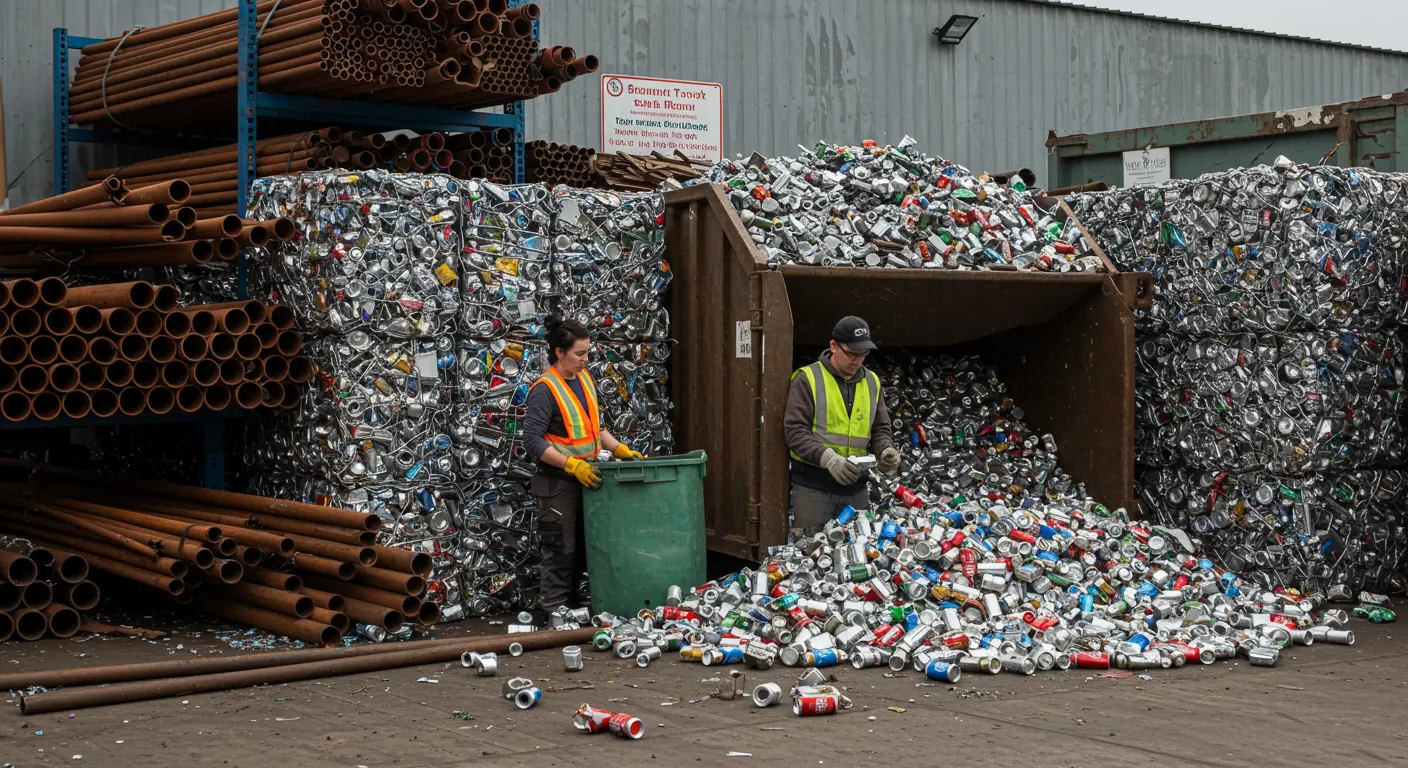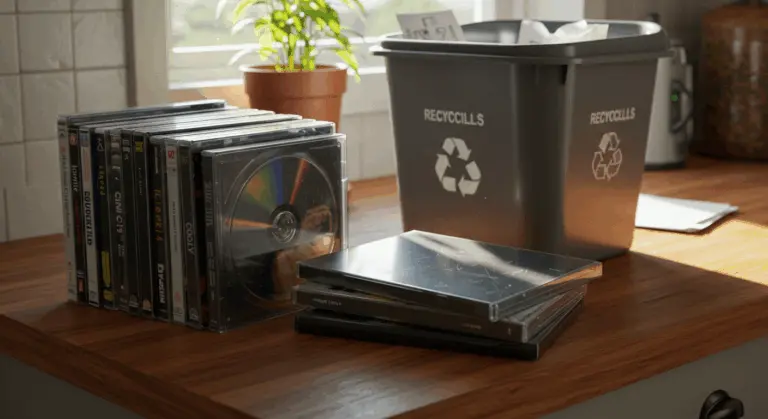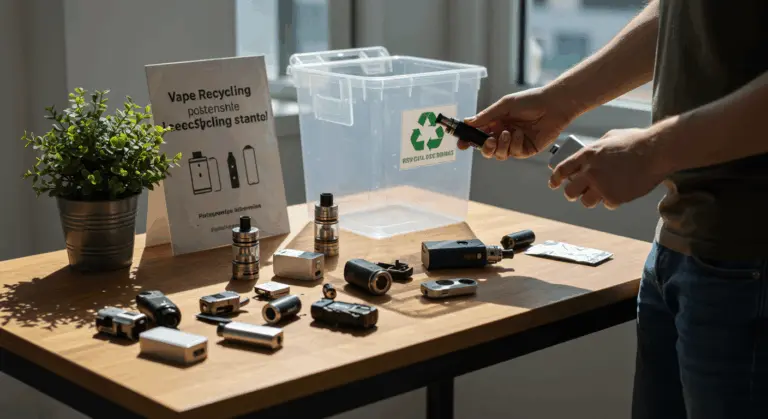Understanding Metal Recycling – Why It Matters
Metal recycling stands as one of the most efficient and impactful forms of resource conservation available today. What makes metal special? Unlike many materials that degrade during recycling, metal is 100% recyclable and maintains its quality through infinite recycling cycles. This remarkable property makes metal a cornerstone of the circular economy—a system designed to eliminate waste and continually reuse resources.
Metal recycling delivers impressive environmental benefits. It dramatically reduces the need for destructive mining operations, preserving natural habitats and protecting biodiversity. Moreover, recycling consumes far less energy than producing metal from raw ore—a difference that translates into significantly lower carbon emissions and enhanced conservation of our planet’s finite resources.
Even simple household recycling of items like aluminum cans and steel food containers makes a real difference. These everyday actions support sustainability goals while preventing valuable resources from ending up in landfills.
Types of Metals That Can Be Recycled
Nearly every type of metal can be recycled, making them one of the most versatile materials in our waste stream.
For residential recycling, the most commonly processed metals include:
-
Aluminum – Found in beverage cans, foil, baking trays, and window frames
-
Steel – Present in food cans, appliances, and construction materials
-
Copper – Common in electrical wiring, plumbing pipes, and electronics
-
Brass – Used in decorative items, musical instruments, and plumbing fixtures
Commercial recycling operations typically handle a broader range of metals, including those found in residential waste plus additional materials such as:
-
Bronze – From statues, bells, and industrial components
-
Lead – Found in batteries and certain industrial applications
-
Zinc – Used in galvanized steel and die-casting
-
Nickel – Common in stainless steel and batteries
-
Silver and Gold – From electronics, jewelry, and specialized industrial applications
Metals like aluminum and copper work especially well in the circular economy because they metals like aluminum and copper, which can be rapidly processed and returned to the manufacturing stream. These metals have strong recycling infrastructures that facilitate their efficient journey from consumer use back into production of new products. This creates a sustainable loop reducing our dependence on virgin material extraction.
Ferrous vs Non-Ferrous Metals – What’s the Difference?
When recycling metals, understanding the difference between ferrous and non-ferrous metals is important. Why? These categories follow entirely different recycling paths and command varying values in the recycling marketplace.
The primary difference lies in their composition: ferrous metals contain iron, while non-ferrous metals do not. This fundamental distinction affects several critical properties that directly impact recycling processes:
-
Magnetic properties – Ferrous metals are typically magnetic, making them easy to identify and separate during the recycling process. Simply using a magnet can help you determine if you’re dealing with a ferrous metal.
-
Corrosion resistance – Non-ferrous metals like aluminum and copper don’t contain iron and therefore don’t rust, though they can still corrode in other ways. Ferrous metals are more susceptible to rusting when exposed to moisture and oxygen.
-
Common examples – Ferrous metals include steel, cast iron, and wrought iron. Non-ferrous metals include aluminum, copper, brass, bronze, lead, zinc, and precious metals like gold and silver.
-
Recycling value – Non-ferrous metals generally command higher prices at scrapyards due to their inherent properties and sometimes greater scarcity.
This distinction becomes particularly crucial when preparing metals for recycling. Many recycling facilities require you to separate ferrous from non-ferrous metals before drop-off. Fortunately, the simple magnet test makes this sorting process accessible—even for those without specialized metallurgy knowledge.
How to Prepare Metal for Recycling
Properly preparing your metal items before recycling helps with processing and increases their recycling value. These steps will simplify the entire recycling process:
-
Clean your metals – Remove any food residue, dirt, or other contaminants from metal items. For food containers like cans, a quick rinse is usually sufficient. Clean metals are more valuable and easier to process.
-
Sort by type – Separate your metals into ferrous and non-ferrous categories using the magnet test mentioned earlier. This pre-sorting saves time at recycling facilities and may increase the value of your scrap.
-
Remove non-metal components – Detach plastic, rubber, wood, or other non-metal parts from your metal items. For example, remove plastic handles from metal pots or rubber grips from tools.
-
Compact when possible – Crush aluminum cans and flatten large metal pieces to save space during transport. This also makes handling easier for recycling centers.
-
Keep valuable metals separate – Metals like copper, brass, and aluminum are worth more than steel, so keep them in separate containers to maximize your return if you’re taking them to a scrapyard.
-
Remove hazardous materials – Ensure that items containing hazardous substances (like batteries or items containing mercury) are handled according to local regulations, as they require special processing.
Larger metal items such as appliances need extra preparation. Refrigerators and air conditioners, for instance, contain refrigerants that certified professionals must properly remove before recycling. Similarly, electronics with metal components often require specialized e-waste recycling processes to handle their complex material composition.
When transporting your prepared metals to recycling facilities, choose sturdy containers that won’t tear or break under weight. Heavy-duty bags, plastic bins, or reinforced cardboard boxes work excellently for smaller items. Larger pieces may need secure fastening in your vehicle for safe transport.
Where to Recycle Metal – Scrapyards and More
Once you’ve properly prepared your metal items for recycling, you need to finding the right destination for them. You have several good options for recycling metal, each offering distinct advantages:
-
Scrapyards: The most comprehensive option, these facilities process various metals and typically pay based on weight and type. They accept a wide range of materials, including:
-
Aluminum (cans, siding, window frames)
-
Copper (wiring, pipes, electronics)
-
Steel (appliances, structural components)
-
Brass (fixtures, musical instruments)
-
Iron (cast iron pans, automotive parts)
-
Stainless steel (kitchen equipment, medical devices)
-
Local recycling centers: A convenient option for common household metals like aluminum and steel cans, though they may not offer payment.
-
Municipal drop-off locations: Cities and towns often provide designated drop-off points for residents. Check your local government website for locations and accepted materials.
-
Curbside recycling programs: These offer home pickup for basic metal items but typically have strict limitations on the types and sizes accepted.
-
Specialty recyclers: Some businesses focus on specific items like electronics (e-waste) or automotive parts, which contain valuable metals.
Before loading up your vehicle with metal items, take a moment to call ahead or check the facility’s website. Verify these essential details:
-
Their business hours and location
-
Which specific metals they accept
-
Any preparation requirements (like removing non-metal components)
-
Documentation needed (some facilities require ID for certain transactions)
-
Payment methods and rates (if applicable)
Most scrapyards and recycling centers follow specific drop-off procedures. Typically, your metal gets weighed and sorted by type, then you receive payment based on current market rates for scrap metal. The facility then processes these materials—cleaning, shredding, and melting them down—before selling them to manufacturers who transform them into fresh products, closing the loop.
Items That Cannot Be Recycled – What to Avoid
While most metals are recyclable, certain metal items and composites cannot be processed through standard recycling channels. Knowing what can’t be recycled helps you recycle responsibly and avoid contaminating recyclable materials.
Several metal-containing items should never find their way into your regular recycling bin:
-
Rusted or disfigured hardware – Nails, screws, and washers that are severely rusted or bent are difficult to process and may be rejected
-
Hazardous items – Metal syringes, razor blades, and other sharp objects pose safety risks to recycling workers
-
Aerosol cans with contents remaining – These can explode during processing if they still contain pressurized material
-
Composite packaging – Items like Capri Sun pouches, smoothie squeeze pouches, and aluminum-lined boxes (for soy milk or soups) combine metal with plastic or other materials that cannot be easily separated
-
Metallic wrappers – Chip bags and candy wrappers with metallic coatings that spring back to their original shape contain too little metal to be valuable for recycling
-
Contaminated containers – Paint cans with wet paint inside or other containers with hazardous residues
-
Kitchen utensils – Many modern utensils combine metal with plastic or other materials that complicate recycling
-
Mirrors – Though they may have metal backing, the glass and chemical coatings make them unsuitable for standard recycling
Other common household items frequently mistaken as recyclable—but requiring special handling or dedicated programs—include:
For items that cannot go in your regular recycling, consider these alternatives:
-
Contact your local waste management authority about special collection events for hazardous materials
-
Look for specialized recycling programs for specific items like batteries
-
Donate usable items like cookware to thrift stores or community organizations
-
For truly non-recyclable items, dispose of them properly in regular trash
If you’re not sure whether a metal item can be recycled, reach out to your local recycling facility. Their guidelines may vary based on the specific equipment and processes they employ. By being selective about what you place in recycling bins, you help ensure that truly recyclable metals can be processed efficiently and effectively.
The Environmental Impact of Metal Recycling
Metal recycling is one of the most environmentally beneficial practices in our waste management systems. It does much more than just reduce landfill waste, offering multiple ecological advantages that ripple through our entire ecosystem.
Recycling metals helps the environment in many ways:
-
Reduced mining impact – When we recycle metals, we significantly decrease the need for extracting virgin ore through mining operations. This preservation of natural habitats protects biodiversity and prevents the landscape disruption, water pollution, and ecosystem damage associated with mining activities.
-
Energy conservation – Recycling metals requires considerably less energy than processing raw materials. For example, recycling aluminum uses approximately 95% less energy than producing it from bauxite ore, while recycling steel saves about 60% of the energy required for new production.
-
Lower carbon footprint – The reduced energy requirements translate directly into lower greenhouse gas emissions. Metal recycling can cut carbon emissions by 200-500 million tons annually worldwide, making it a powerful tool in combating climate change.
-
Water conservation – Metal production from raw materials is extremely water-intensive. Recycling metals can reduce water consumption by up to 40% compared to virgin material processing.
-
Reduction in air pollution – The smelting and processing of virgin metals release significant amounts of air pollutants, including sulfur dioxide and particulate matter. Recycling dramatically reduces these emissions.
Metal recycling also brings economic benefits. Consumers can receive financial compensation for recycling scrap metal, while manufacturers benefit from reduced production costs when using recycled materials. This economic incentive drives participation in recycling programs and generates jobs throughout the recycling industry.
By participating in metal recycling, individuals and businesses contribute to a more sustainable future while often reaping economic benefits. This mix of environmental protection and economic incentive makes metal recycling one of our most successful and vital sustainability practices.
Metal Recycling Guidelines – What You Need to Know
To recycle metal properly, you need to know and follow specific guidelines that vary by location and facility. Knowing these rules ensures your metal waste gets properly processed and actually recycled—rather than rejected and sent to landfill.
Follow these important rules to follow when recycling metal:
-
Check local requirements – Recycling regulations differ significantly between municipalities. Contact your local recycling center or visit their website to learn their specific requirements before dropping off materials.
-
Understand size and type restrictions – Many facilities have limitations on the size, weight, or dimensions of metal items they accept. Large appliances or industrial metal pieces may require special handling or need to be taken to specialized recycling centers.
-
Separate different metal types – When possible, sort your metals by type (aluminum, steel, copper, etc.). This separation increases the efficiency of the recycling process and may even result in higher compensation at scrapyards that pay by weight and metal type.
-
Clean your metals – Remove non-metal components, food residue, and other contaminants before recycling. Dirty or contaminated metal may be rejected or reduce the quality of recycled material.
-
Remove hazardous components – For appliances and electronics, remove batteries, refrigerants, oils, and other potentially hazardous materials before recycling the metal components.
-
Check for special handling items – Some metal items require special handling due to potential hazards or complex composition. These include aerosol cans (which must be completely empty), paint cans (which must be dry and free of residue), and electronics (which often contain various metals mixed with other materials).
Most recycling centers have preparation requirements to make their work easier:
-
Crushing aluminum cans to save space
-
Removing labels and adhesives when possible
-
Bundling similar items together
-
Using designated containers for drop-off
For businesses generating significant metal waste, building relationships with local recycling facilities pays off. Many recyclers offer pickup services for commercial clients and can provide tailored guidelines specific to your business’s waste stream.
Remember that following these guidelines not only ensures proper recycling of your metal but also helps maintain the efficiency and sustainability of the entire recycling system. Taking a few extra minutes to prepare your metal items according to local requirements increases the environmental benefits of metal recycling.




